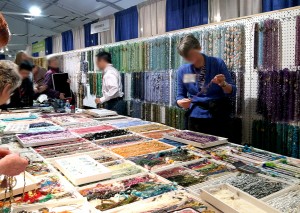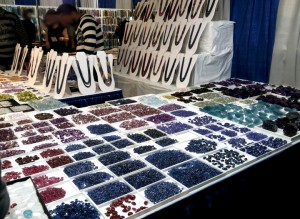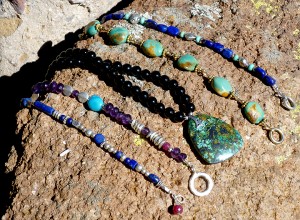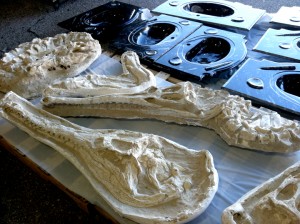Recently we made our 12th annual pilgrimage to the Tucson Gem and Mineral Show, an event that never ceases to amaze us! (And exhaust us!) Our primary reason for attending is so that Becky can purchase the semi-precious stones and beads she needs to create her unique jewelry, which is available for purchase in the Art Gallery at Casitas de Gila Guesthouses and also online at www.southwest-turquoise-jewelry.com. (See our blog entry of February 2011 for background information on the show and on Southwest Turquoise.)
In the two days we spend in Tucson, we can only manage to work our way through three tents of precious and semi-precious stones and beads and merchandise, all of it offered to the wholesale trade. But we also manage, after a quick breakfast the second morning, to check out a few fossils in the tents along I-10 before the main shows open at 10 AM.
A click on the photo will give you a larger version, so you can really see the gems!




Michael, being a geologist, loves rocks, and loves to look at the incredible collection of fossils for sale at the Tucson Gem and Mineral Show. Like the gems, rocks and minerals portion of the Tucson Show, various venues have extensive presentations of fossils, ranging from microscopic insects in amber from the Baltic Sea area to large crocodile skulls from Morocco. In recent years, fossils from Morocco have become very abundant at the Tucson Show. Most common are marine invertebrate fossils, such as trilobites, ammonites, and crinoids, which can be anywhere from 500 million years (Cambrian Period) to 65 million years (Cretaceous Period) old, depending on the species and rock strata in which they occur. For the collector of fossils, whether professional or amateur, the volume, number and varieties of species available for purchase is simply amazing. But, as is also the case when purchasing gems and jewelry at the show, one needs to be cautious when purchasing fossils, as one will soon find that certain specimens may not be entirely authentic, having been “modified”, “restored”, or “reconstituted” in some way. If total authenticity is a key issue when purchasing a fossil specimen, it is always advisable to check with experts where possible, ask direct questions regarding provenance and how the specimen was prepared, and, certainly in the case of expensive specimens, deal only with reputable dealers who will give a binding certificate of authenticity. There are various websites that provide good information as to features one can look for when trying to decide if a specimen is authentic or “modified“.

Moroccan trilobites are from Cambrian, Ordovician, and Devonian rocks, from 500 to 360 million years old. In recent years, with the introduction of high tech preparation tools, exotic 3-D specimens of Moroccan trilobites have become common on the open market.
Fossil Crocodile Skull — Late Cretaceous Period, 65-70 million years old

A very common product of the Moroccan fossil industry are various objects, including these sinks, made from a Devonian limestone containing abundant ammonite fossils. Have a look at this link showing Moroccan workers polishing ammonites and cutting the limestone.
This is a slab showing a death-assemblage of Crinoids from Southern Morocco that died on the bed of an ancient sea floor. They are from the Upper Silurian Period and are 420 million years old.





